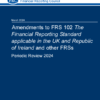
by John McCarthy Consulting Ltd. | May 10, 2017 | News
FRS 102 – Interim relief for Treatment of Directors’ Loans
by John McCarthy
On Monday 8 May 2017, the Financial Reporting Council (FRC) issued a press release on director’s loan reporting for small companies. It has announced that it is withdrawing the requirement to find a market rate of interest where a loan is made on an off-market basis under Irish GAAP. This is an unusual move for the FRC, as it is making the change without consultation, presumably on the basis of demand from the profession.
In March, the FRC published Financial Reporting Exposure Draft 67 (FRED 67) which set out changes to FRS 102 as a result of the first triennial review, outlining potential changes to be made to director’s loans accounting. We will cover the changes in this FRED in a future blog.
The FRC has now responded to calls to create an interim optional exemption for small companies, allowing them to measure a basic financial liability that is a director’s loan initially at transaction price.
The FRC Press Release states: ‘A small entity, as an exception to paragraph 11.13, may measure a basic financial liability that is a loan from a director who is a natural person and a shareholder in the small entity (or a close member of the family of that person) initially at transaction price. Subsequently, for the same financial liability, a small entity is also exempt from the final sentence of paragraph 11.14.’
The measure announced applies to credit loans. The FRC has clarified that the interim measure will not apply to loans from small companies to their directors/shareholders i.e. debit loans.
As it is an interim measure, the amendment will be deleted as part of the finalisation of FRED 67, expected around January 2018. It will then be replaced with permanent requirements based on the proposal in FRED 67 after the outcome of the consultation process. The changes in FRED 67 are not expected to come into effect until periods commencing 1 January 2019, but early adoption may be allowed.
The FRC said: ‘Whilst it is usual for the FRC to consult formally on amendments to an extant standard, the FRC has concluded that this is not essential in this case as the amendment is only an interim measure, it merely defers for many entities the first-time application of an accounting policy of measuring such loans initially at present value and the permanent removal of this policy is already subject to an on going consultation.’
‘We have also explained that, in the context of owner-managed businesses in particular, many question the value of the notional interest charge to profit or loss in such circumstances, especially where the notes to the accounts adequately disclose the nature and terms of outstanding directors’ loans.’
For more on FRS 102 and the proposed changes in FRED 67 come to our next CPD course at the Talbot Hotel Stillorgan County Dublin on Monday 27 November. For more details and online bookings see here.
Other courses are also available at Ticket Tailor here.

by John McCarthy Consulting Ltd. | Apr 11, 2017 | News
Top Tips for Preparing for an Audit Quality Review
– Over reliance on financial statements presentation software without verifying the disclosures are correct in accordance with the Companies Act 2014 and FRS 102. Chartered Accountants Ireland has some very useful toolkits to help check the financial statements disclosure references. For more details see https://www.charteredaccountants.ie/en/Site/Shop/Publications/Practice-Toolkits/.
– Note on the audit file any critical judgements or assessments made as others reading the file may not come to the same conclusion. These notes should be written clearly to justify the audit treatment adopted.
– Answering “Y”, ‘N’, or ‘N/A’ to questions in an audit programme or checklist must have some supporting corroborative evidence of why this is the correct answer. Just because it was the right answer last year, does not always make it the right answer this year (even allowing for a change in accounting standards).
– Related parties and beneficial owners – the audit team need well briefed in advance of the audit commencing. If someone can influence the company, irrespective of whether they have entered into any transactions with the party or there is any required disclosure, the audit team must be briefed about them e.g. premises rented from a related party landlord at a zero-rental charge, is still a related party ‘transaction’ and disclosable if the market rent that would have been charged by a third party, would have been material. The audit team, including juniors need properly briefed, if they are to flag up otherwise undisclosed related party transactions.
– Often, a free quick search on the CRO website, will highlight other directorships previously unreported. Directors’ spouses, parents, children and business interests can be incorrectly omitted from the relevant financial statements disclosures.
– With the new requirement on Irish corporates from 15 November, 2016, to keep a register of ‘beneficial owners’ for anti-money laundering legislative purposes, auditors will need to check that the ultimate beneficial owners, as disclosed on that register, correspond to those disclosed in the company’s financial statements.
– Going concern evidence is another frequent bugbear on audit files. If the company is planning to stop trading in the next year, it is not a going concern. It is therefore important to ascertain and document the future business plans of the directors and shareholders, (e.g. to inject more working capital or file for liquidation). It is not enough to say that there is a positive balance sheet. If the sole director/employee, is planning to retire, then the business may not be a going concern and the financial statements need to reflect this. As a result, the financial statements may need prepared on a ‘break-up’ basis.
– Always follow up bank enquiry responses and get them back before the audit is signed off. Watch for related party information contained in the replies such as directors’ personal guarantees and life assurance policies given as security for borrowings.
– Note the difference between ‘immaterial errors’ and ‘trivial errors’. Immaterial errors need to be noted down for consideration while, trivial ones don’t. See Practice Note 26 (PN26) Guidance on Smaller Entity Audit Documentation.
– Where stock is material, the auditor is not absolved from stock take attendance even if there are expert stocktakes present. Expert stocktakers tend to be more prevalent in supermarket and pharmacy audits. Their presence is a useful addition to the audit evidence available to the external auditors, but the statutory auditor is still responsible for attending the stocktake (PN25 Attendance at Stocktaking and ISA (Ireland) 501 Audit Evidence – Specific Considerations for Selected Items) and assessing the work of the expert stocktakers under ISA (Ireland) 620 Using the Work of an Auditor’s Expert.
– FRS 102 has lots of useful exemptions with which to become well acquainted: Section 35.10 which can only be used once on transition, paragraph 1.8 for subsidiary company accounts, and Section 33.1a for related party transactions in wholly owned groups.
– Once FRS 102.1A is triggered for ‘small’ companies, upon the signing into law of the delayed Companies (Accounting) Bill, 2016, it will open up many other useful exemptions for certain ‘small; entities including the exemption from presenting the statement of cash flows.
– FRS 101 has some useful disclosure exemptions for Irish/UK subsidiary companies preparing IFRS financial statements and already includes the exemption from presenting the statement of cash flows.
– Audit report signatures must use the label ‘Statutory Auditor’ or ‘Statutory Audit Firm’. The term ‘Registered Auditor’ no longer exists under company law.
To read more details about how to prepare for an Audit Quality Review continue reading below.
This article attempts to give some tips on the ‘good’ and the ‘not so good’ aspects of audit quality review visits to small and medium practices. I hope to highlight some of the more common issues that can arise and how to ensure that your firm does not fall into the ‘not so good’ category.
A Quality Review visit from the Professional Standards Department (formerly CARB) of the Institute, assesses the firm’s compliance with the Audit Regulations 2017, Anti-Money Laundering, Insolvency and Investment Business Regulations (September 2016) and compliance with the Professional Practice Regulations (amended October 2015) (which include the Clients’ Money requirements and Continuing Professional Development Regulations). This article does not deal with insolvency and investment business reviews.
During the review the preparation of statutory financial statements and compliance with FRS 102 and the Companies Act, 2014 disclosure requirements will also be assessed.
The Professional Standards Department also verifies compliance with the Code of Ethics (January 2014) and the IAASA Ethical Standard for Auditors (Ireland) 2016 (effective from 17 June 2016) and is the primary means by which CARB checks the quality of the professional work within practising firms of chartered accountants. For accounting periods commencing on/after 17 June 2016, the IAASA International Standards on Auditing (Ireland)will apply, while the ISAs (UK and Ireland) issued by the Financial Reporting Council applied to audits of financial statements for periods commencing before that date.
The key to a successful quality review visit, is always preparation. This preparation will involve having a detailed knowledge of the audit issues around the new accounting framework in Ireland, FRS 102, effective for accounting periods from 1 January 2015 for medium and large private companies and for ‘small’ entities for accounting periods commencing on 1 January 2016.
The implementation of FRS 102 (August 2014 version, as amended in February 2015) has, with some exceptions, been straightforward. Where there are transition adjustments, findings to date show that these are not always well supported with proper audit evidence, especially regarding the independent verification of the fair values obtained.
The audit standards require the auditor to display a sufficient degree of scepticism in their work. For example, one should not assume that just because the directors claim that a company is dormant but requires an audit, that it really is dormant. One cannot be said to have carried out an effective audit without doing the corroborative research and obtaining appropriate written representations. Not preparing a proper audit file to support the audit opinion, is like not warming up properly before a race.
Reference should be made within the Audit Planning Memorandum (APM) to connect specific significant risks on the audit with the actual tests carried out e.g. for a supermarket audit it may be turnover and stock completeness, while for an audit of a quarry, it might be the restoration provision.
There should be a link between the audit assertion (e.g. completeness, cut-off, existence etc.) and the individual tests executed. It must be clear what assertions are being audited and the outcome of each test should be properly documented (e.g. whether the result is satisfactory or unsatisfactory, and if the latter, there should be a file note explaining the nature of the further work carried out).
Analytical review (ISA (Ireland) 520 Analytical Procedures) documentation needs to contain plenty of appropriate explanatory text to show why the numbers have or have not changed year on year, taking into account matters such as consideration of different revenue lines, expectations based on activity etc.
A compulsory part of ‘ISA (Ireland) 315 Identifying and Assessing the Risks of Material Misstatement Through Understanding of the Entity and Its Environment’ is the requirement that audit files show clearer evidence of testing journal entries (paragraph 18 (f)). This is because many frauds have been perpetrated using seemingly innocuous journals to cover them up. Some auditors are now using audit data analytics tools like IDEA (Information Data Extraction and Analysis) to isolate outliers like unusual journals that merit further audit scrutiny.
Sample size selection often needs better explanation in the planning section of the audit file as well as more detail about the sampling method used e.g. selected top 20 items, then 10 random above performance materiality.
Quite often, too much testing is done on trade creditors e.g. when a supplier statement is available, it is unnecessary to check post year end payments as well.
On prepayments, there is no need to recalculate very figure and no need to place a copy of the supporting invoice on file to support every figure, especially when they are below materiality.
With trade debtors’ verification to post year end cash receipts, audit files often neglect to show that the recorded remittances post year-end, actually relate to pre-year-end sales.
Be prepared
Some of the most critical things to double check, has your firm:
1. Carried out its whole firm annual compliance quality control review and documented the action plan arising as a result?
2. Carried out the required number of audit, clients’ money and investment business cold file reviews (usually one file per partner) and documented the key action points arising?
3. Communicated and documented the findings of these internal reviews to relevant audit staff and partners?
4. Updated its professional indemnity cover?
5. Had the annual independence, fit and proper and confidentiality declarations completed by all relevant partners and staff including sole proprietors making the declarations for themselves?
6. Got the clients’ money five weekly bank reconciliations and bank letter of trust (for the Clients’ Money Bank Accounts) in place?
7. Up to date employment contracts with all staff and documented staff appraisals for all audit personnel?
8. Checked that, where the firm has recently incorporated its audit service, it has made the necessary arrangements for any student trainee contracts to be registered with the Institute Education Department, in the new entity’s name.
9. Got up to date CPD records for all relevant partners (recorded on the output model since 1 July 2016 under International Education Standard 8 (IES 8)) and updated CPD records for all other audit personnel?
10. Written audit quality control procedures in place to deal with the ‘International Standard on Quality Control for firms that perform audits and reviews of historical financial information and other assurance and related engagements’ (ISQC 1)?
If you have answered ‘no’ to any of the above questions or you are unsure of the answer, please start doing your homework now. These are some of the many items examined during a review.
Further reading
1. The Professional Standards Department newsletter called the ‘Professional Standards Regulatory Bulletin’, publication of which is flagged in the Institute’s weekly E-News e-mailed to members on Friday afternoons. The archive of back issues of the newsletter is available on the Professional Standards Department website at www.carb.ie and is well worth a look. The latest edition is number 21, dated March 2017.
2. The May 2016 edition of the Bulletin is also a must read as it contains a link to an updated feedback paper from the Quality Assurance Team alerting firms to common matters arising on audit and money laundering inspections to help them identify possible areas of improvement for firms.
3. ‘Guidance on Quality Review Visits’ (updated December 2014) is also on the Professional Standards Department website and gives further information on how the review process operates.
This is an edited version of an article that appeared in the April 2017 of Accountancy Ireland, the journal of Chartered Accountants Ireland.

by John McCarthy Consulting Ltd. | Mar 13, 2017 | News
Under the code of ethics of the professional accountancy bodies, it is mandatory for accountancy practices, when signing up a new or existing client, to obtain a signed letter of engagement setting out the terms of the business agreement and contracted services. This blog provides tips and advice on writing effective engagement letters to avoid unnecessary client disputes.
The letter of engagement is a formal letter and is in fact a contract between the accounting or audit firm and the client. Among the many purposes of the letter is to ensure that all parties are aware of their respective responsibilities, resulting in greater clarity and hopefully fewer disputes and/or misunderstandings.
Regulated work
Formal engagement letters are mandatory for audit work and investment business advice. Certain clauses are mandatory for inclusion in engagement letters, e.g. clients’ right to complain to the firm (usually a contact name in the firm for complaints, is stated in the letter) and to the professional body of the advising firm, in the event of a complaint being unresolved. Another clause will refer to the latest anti-money laundering legislation, the Criminal Justice (Money Laundering and Terrorist Financing) Act, 2010.
A commission retention clause, is mandatory, where the firm has recommended goods or services (e.g. advising the client to seek advice from an external financial adviser) to the client, for which it will earn a commission, about which the client might otherwise be unaware.
Dispute resolution
Once a dispute arises, the letter of engagement can play an important role in helping find common ground and resolve disputes quickly, including fee disputes. The letter of engagement is often the first document requested by professional indemnity insurers in the event of a dispute, which has developed into a claim.
The lack of a well worded engagement letter will often result in an unfavourable outcome for the accounting firm. Hence, it is essential that the letter is both complete and up to date.
In a 2009 case, involving outstanding fees, discounted to around £70,000, heard in the High Court of Justice in Belfast, Northern Ireland, the judge held against the accountancy firm on various grounds, including the fact they had no engagement letter after 20 years of service to the client that owed the money. ‘Based on the evidence, I find that during a period of some twenty years there was no retainer note, no written contract and no breakdown of hourly rates of remuneration’.
Regulated work
Engagement letters are mandatory for regulated work including charities and investment/insurance intermediaries. Engagement letters are extremely important where there is an increased likelihood of dispute, such as in business valuations, profit projections, cashflow forecasts and business plans.
For some reason, these are the areas where engagement letters are most often ignored, perhaps due to the lack of formal guidance and the degree to which reliance is necessarily placed on senior management, making formal documentation of respective responsibilities all the more important.
Matters outside the scope of the service
It is recommended best practice that engagement letters include negative clauses, clearly stating what the practice will not do for the client, (e.g. management accounts, VAT returns) besides covering the work that has already been agreed to be done.
A copy of the letter should be signed by the client and returned as positive evidence of their acceptance of the terms. Best practice is to obtain positive evidence of acceptance of the terms. i.e. get the client to sign and return a copy of the letter to indicate their agreement. Adobe Sign is a useful tool that facilitates engagement letters to be sent electronically by mail and allows the client to sign off quickly, all the while tracking and electronically storing the signed documents for both parties.
What needs to be included?
The engagement letter should include the following:
1. Cover letter/key facts;
2. Standard terms of business/limitation of liability;
3. Reference to the appropriate accounting framework such as FRS 102 or IFRS;
4. Audit;
5. Accountant’s report (i.e. audit exemption and unincorporated entities);
6. ‘Agreed upon Procedures’ such as under the International Federation of Accountants ISRS 4400, where an auditor simply provides a report of the factual findings of agreed-upon procedures and where no assurance is expressed. Users of such reports assess for themselves, the procedures and findings which are reported by the auditor and draw their own conclusions from the auditor’s work
7. Accounting services e.g. accounts production, management accounting, bookkeeping;
8. Taxation services;
9. Other services e.g., payroll, VAT returns, company secretarial services;
10. Specialist reporting requirements, e.g. Central Bank requirements for insurance brokers and the Accountants’ Report to the Law Society under the Solicitors Accounts Regulations, 2014.
It is not permitted to include a limitation of liability clauses in respect of audit work. However, for non-audit work it is possible to include a limitation of liability clause in an audit engagement letter. Users should seek legal advice regarding the wording of such clauses.
Example of a liability cap for the professional accountants’ reporting engagement
The aggregate liability, whether to [insert name of client] or [insert name of third party] or any other party, of whatever nature, whether in contract, tort or otherwise, of [insert name of professional accountants] for any losses whatsoever and howsoever caused arising from or in any way connected with this engagement [and this transaction] shall not exceed [insert amount].
To access some ready-made and up to date templates of engagement letters, please visit our website at https://jmcc.ie/d7/content/publications

by John McCarthy Consulting Ltd. | Nov 25, 2016 | News
With effect from 15 November, 2016, companies and other bodies corporate, registered in Ireland are obliged to collect and retain adequate, accurate and current information on the beneficial ownership of interests held in those entities.
Entities and beneficial owners that breach the requirements face fines of €5,000 on summary conviction. This requirement was brought into law by S.I. 560 of 2016.
This initial requirement for entities to gather the names of beneficial owners precedes the preparation by Government under EU law for each Member State to prepare a register of beneficial powers to make the AML due diligence process easier and the ultimate ownership of each company more transparent.
The register must contain the name of the natural person who holds the underlying beneficial ownership of an interest in a corporate or other entity in Ireland. This legislation is derived from the EU Fourth Money Laundering Directive, which the UK has already implemented with effect from 1 July 2016 where the beneficial owners of UK companies and LLPs appear on the register of Persons of Significant Control (PSC register). Note that the requirements in Ireland may not be identical to the UK ones.
The term ‘beneficial owner’ is defined as the ‘natural person or persons ultimately controlling a legal entity through direct or indirect ownership of a sufficient percentage of the shares or voting rights or ownership interest in that entity. A shareholding of 25 % plus one share or an ownership interest of more than 25 % in the customer held by a natural person shall be an indication of direct ownership. A shareholding of 25 % plus one share or an ownership interest of more than 25 % in the customer held by a corporate entity, which is under the control of a natural person(s), or by multiple corporate entities, which are under the control of the same natural person(s), shall be an indication of indirect ownership’. More details of the process and the various definitions are in the Statutory Instrument.
There is a corresponding duty on beneficial owners to notify any changes in their ownership interests to the relevant entity.










